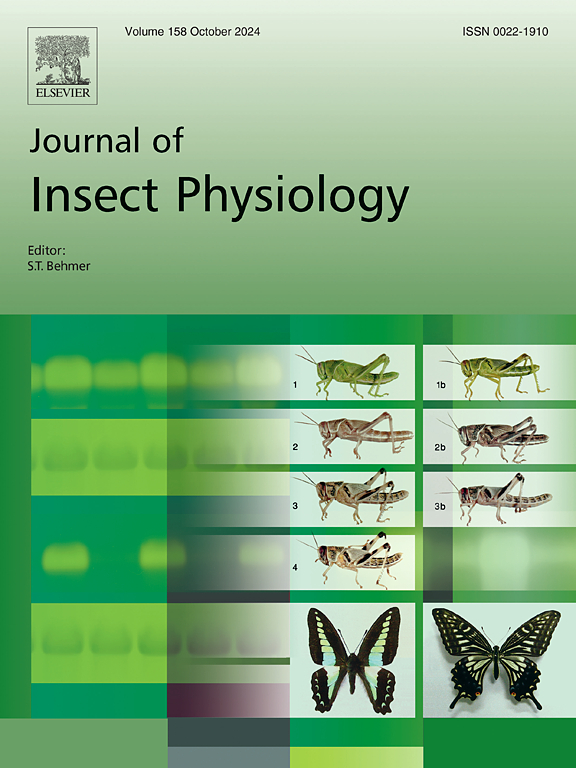Corticotropin-releasing factor-like diuretic hormone 44 and five corresponding GPCRs in Drosophila suzukii: Structural and functional characterization
IF 2.3
2区 农林科学
Q1 ENTOMOLOGY
引用次数: 0
Abstract
Diuretic hormones (DHs) activate corresponding G protein-coupled receptors (GPCRs), mediating the water and ion homeostasis in arthropods. There are two different DHs known to be expressed in insects, calcitonin (CT)-like DH31 and corticotropin-releasing factor (CRF)-like DH44. In this study, we identified and characterized a DH44 and five GPCR variants, DH44-R1 and DH44-R2a/b/c/d, in Drosophila suzukii (spotted-wing drosophila), causing detrimental damage to fresh and soft-skinned fruits. Among the five DH44 receptors, DH44-R1 was the longest GPCR and most strongly responded to DH44, and the other DH44-R2 splicing variants were relatively shorter and over 90 % similar to each other. Some DH44-Rs including DH44-R1 utilized both cAMP and Ca2+ as second messengers. Interestingly, DH44-R1 was dominantly expressed in the brain, whereas DH44-R2 variants were dominant in the digestive organs, particularly the Malpighian tubules (MTs) by their gene expressions. The results suggest that DH44 may have multiple physiological functions, including the regulation of the sleep-wake cycle and diuretic activity. Injection of DH44 stimulated fluid secretion in adults, and the rate of the excretion increased in a dose-dependent manner. Moreover, when the flies were injected with a mixture of DH31 and DH44, a high mortality rate was observed. Here, we demonstrate the gene structures, expressions, characterization of DH44 and five GPCRs, their second messengers, and the effects of DH peptides on the fly. These investigations offer molecular insights into the physiological roles of the DH system and may assist in the fundamental aspects of developing D. suzukii management in the field.

苏氏果蝇促肾上腺皮质激素释放因子样利尿激素44和5个相应的gpcr:结构和功能表征。
利尿激素(Diuretic hormone, DHs)激活相应的G蛋白偶联受体(gpcr),介导节肢动物体内水分和离子的稳态。已知昆虫中表达两种不同的DHs,降钙素(CT)样DH31和促肾上腺皮质激素释放因子(CRF)样DH44。在这项研究中,我们鉴定并鉴定了一个DH44和五个GPCR变异DH44- r1和DH44- r2a /b/c/d,对新鲜和软皮果蝇造成有害损害。在5个DH44受体中,DH44- r1是最长的GPCR,对DH44的应答最强烈,其他DH44- r2剪接变异体相对较短,相似度在90% %以上。包括DH44-R1在内的一些DH44-Rs同时利用cAMP和Ca2+作为第二信使。有趣的是,DH44-R1主要在大脑中表达,而DH44-R2变体主要在消化器官中表达,特别是马尔比氏小管(MTs)。结果表明,DH44可能具有多种生理功能,包括调节睡眠-觉醒周期和利尿活性。注射DH44刺激成人体液分泌,排泄率呈剂量依赖性增加。此外,DH31和DH44混合注射后,果蝇死亡率较高。在这里,我们展示了DH44和五种gpcr及其第二信使的基因结构、表达、特征,以及DH肽对果蝇的影响。这些研究为DH系统的生理作用提供了分子见解,并可能有助于在该领域发展铃木氏菌管理的基本方面。
本文章由计算机程序翻译,如有差异,请以英文原文为准。
求助全文
约1分钟内获得全文
求助全文
来源期刊

Journal of insect physiology
生物-昆虫学
CiteScore
4.50
自引率
4.50%
发文量
77
审稿时长
57 days
期刊介绍:
All aspects of insect physiology are published in this journal which will also accept papers on the physiology of other arthropods, if the referees consider the work to be of general interest. The coverage includes endocrinology (in relation to moulting, reproduction and metabolism), pheromones, neurobiology (cellular, integrative and developmental), physiological pharmacology, nutrition (food selection, digestion and absorption), homeostasis, excretion, reproduction and behaviour. Papers covering functional genomics and molecular approaches to physiological problems will also be included. Communications on structure and applied entomology can be published if the subject matter has an explicit bearing on the physiology of arthropods. Review articles and novel method papers are also welcomed.
 求助内容:
求助内容: 应助结果提醒方式:
应助结果提醒方式:


